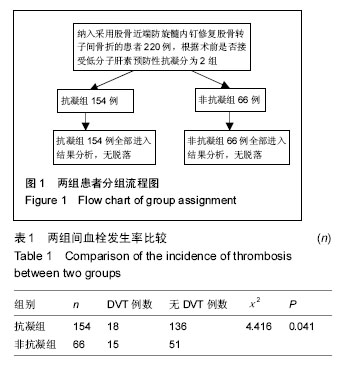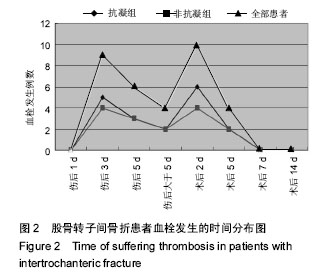| [1] 魏俊强,王新宇,金宇,等.利伐沙班对股骨转子间骨折术后失血风险和深静脉血栓形成效果及安全性研究[J].解放军医药杂志,2015,27(10):95-98.
[2] Della Valle CJ, Mirzabeigi E, Zuckerman JD, et al. Thromboembolic prophylaxis for patients with a fracture of the proximal femur. Am J Orthop (Belle Mead NJ). 2002;31(1): 16-24.
[3] 张辉良,梁俊生,张洪斌.不同药物对预防骨折围手术期下肢深静脉血栓形成的对比[J].实用医学杂志,2012,28(2): 293-294.
[4] Park MS, Perkins SE, Spears GM, et al. Risk factors for venous thromboembolism after acute trauma: A population-based case-cohort study. Thromb Res. 2016;29(144):40-45.
[5] Protty MB, Aithal S, Hickey B,et al.Mechanical prophylaxis after hip fracture: what is the risk of deep vein thrombosis? A retrospective observational study. BMJ Open. 2015;5(2):1-5.
[6] 唐颖,郭庆山,赵玉峰,等.创伤骨折并发下肢深静脉血栓的危险因素分析[J].中华创伤杂志,2010,26(12):1122-1125.
[7] 中华医学会骨科学分会.中国骨科大手术静脉血栓栓塞症预防指南[J].中华骨科杂志,2009,29(6):602-604.
[8] 中华医学会骨科学分会.中国骨科大手术静脉血栓栓塞症预防指南[J].中华骨科杂志,2016,36(2):65-71.
[9] 邱贵兴,裴福兴,胡侦明,等.中国骨质疏松性骨折指南[J].中华骨与关节外科杂志,2015,8(5):371-375.
[10] 10.Cosman F, de Beur SJ, LeBoff MS, et al. Clinician's guide to prevention and treatment of osteoporosis. Osteoporos Int. 2014;25(10): 2359-2381.
[11] 中华医学会骨质疏松和骨矿盐疾病分会.原发性骨质疏松症诊治指南(2011年)[J].中华骨质疏松和骨矿盐疾病杂志,2011,4(1):2-17.
[12] 张智海,刘忠厚,李娜.中国人骨质疏松症诊断标准专家共识(第三稿•2014版)[J].中国骨质疏松杂志,2014,20(9): 1007-1010.
[13] 洪磊,樊华俊,李文,等.老年性骨质疏松患者骨折的临床特点及治疗措施研究[J].实用临床医药杂志,2015, 19(23): 197-201.
[14] 眭文洁,陈小康,陆秀珍,等.老年患者再发骨质疏松性骨折的发病特点[J].中国老年学杂志,2014, 34(16):4624-4625.
[15] 马京华,薛娜娜,纪敬敏,等.多元化健康教育对老年骨质疏松骨折患者生活质量的影响[J]. 中国老年学杂志,2015, 35(6):1667-1669.
[16] Cousin O, Le Hello C, Barrellier MT.Incidence and distribution of venous thrombosis of the lower limbs diagnosed by duplex ultrasonography after total hip or total knee arthroplasty, and hip fracture surgery. Results from 5981 exams and 2123 cases of venous thrombosis over 10 years.J Mal Vasc.2011;36(4):243-253.
[17] 肖湘,冯凯强,袁宇,等.老年骨质疏松性髋部骨折患者术前下肢深静脉血栓患病率及危险因素分析[J].中华骨科杂志,2015,35(11):1084-1090.
[18] 王强,盛伟斌,姜曙祥,等.老年髋关节周围骨折应用低分子肝素预防下肢深静脉血栓的研究[J].中国骨与关节损伤杂志,2015,25(2):164-165.
[19] Li J, Cheng L, Jing J.The Asia proximal femoral nail antirotation versus the standard proximal femoral antirotation nail for unstable intertrochanteric fractures in elderly Chinese patients. Orthop Traumatol Surg Res. 2015;101(2):143-146.
[20] 彭志平,林云.彩超对下肢深静脉血栓筛查的意义[J].中国超声医学杂志,2013,29(2):167-169.
[21] 何文.下肢深静脉血栓形成的超声检查[J]. 中华医学杂志,2003,83(7):615-616.
[22] 中华医学会外科学分会血管外科学组.深静脉血栓形成的诊断和治疗指南(第2版)[J]. 中华外科杂志,2012, 50(7):611-614.
[23] Smith EB, Parvizi J, Purtill JJ.Delayed surgery for patients with femur and hip fractures-risk of deep venous thrombosis. J Trauma. 2011;70(6):113-116.
[24] Hill J, Treasure T.Guideline Development Group. Reducing the risk of venous thromboembolism (deep vein thrombosis and pulmonary embolism) in patients admitted to hospital: summary of the NICE guideline. Heart. 2010;96(11):879-882.
[25] Eriksson BI,Borris LC,Friedman RJ,et al.Rivaroxaban versus enoxaparin for thrombprophylaxis after hip arthroplasty. N Engl J Med. 2008;358(26):2765-2775.
[26] Dietch ZC, Petroze RT, Thames MT, et al.The "high-risk" deep venous thrombosis screening protocol for trauma patients: Is it practical? Trauma Acute Care Surg. 2015;79(6):970-975.
[27] Lu Y,Ma B,Guo R,et al.Deep vein in thrombosis in trauma:a prospective study of lower limb orthopeadic trauma patients in Tianjin Hospital.China.Int Angiol. 2007;26(2):165-170.
[28] 陆芸,马宝通,郭若霖,等.骨科创伤患者深静脉血栓危险因素的研究[J].中华骨科杂志,2007,27(9):693-698.
[29] Marsland D, Mears SC, Kates SL. Venous thromboembolic prophylaxis for hip fractures. Osteoporos Int. 2010;21(Suppl 4): S593-S604.
[30] 陈戬宏,息子龙,袁柱.全髋关节置换后对深静脉血栓的综合预防[J].中国组织工程研究,2015,19(17):2642-2647.
[31] 杨庆铭,王鸿利.骨科大手术后静脉血栓栓塞症预防的临床趋势[J].中华骨科杂志,2015,25(11):1121-1128.
[32] 赵宇驰,张树栋,于明伟,等.药物联合间歇充气加压装置预防关节置换术后下肢深静脉血栓的随机对照研究[J].中华骨科杂志,2015,35(11):1091-1095.
[33] 李涛,吕明,李庆涛.综合防治法预防老年人股骨近端骨折下肢深静脉血栓形成的比较研究[J].中国修复重建外科杂志,2008,22(4):453-455.
[34] 董玉金,张铁慧,钟声,等.创伤骨折患者深静脉血栓形成的危险因素分析[J].中华创伤骨科杂志,2015,35(11): 1077-1083.
[35] 杨林,张利召,居永平,等.股骨干骨折并发下肢深静脉血栓的危险因素分析[J].中华创伤骨科杂志,2015,17(9): 751-756. |
.jpg)



.jpg)